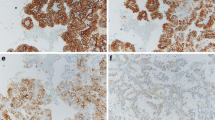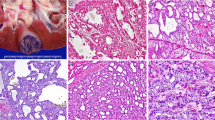Abstract
Histological features are usually sufficient for providing an accurate diagnosis of renal cell carcinomas (RCC). However, the morphological appearance might sometimes be misleading. For instance, RCC with papillary areas and extensive clear cell changes may be difficult to classify either as clear cell renal carcinoma or as papillary renal cell carcinoma (pRCC). We used the combination of immunohistochemistry, conventional cytogenetics, fluorescence in situ hybridization (FISH), bacterial artificial chromosomes comparative genomic hybridization arrays and high-density single nucleotides polymorphism arrays (SNP arrays) to characterize three cases of RCC showing a predominant cytology of cells with clear cytoplasm and variable amounts of papillary areas. In accordance with the 2004 World Health Organization (WHO) classification, we initially assessed the diagnosis of clear cell RCC for one of the cases and unclassified RCC for the two remaining cases. However, because of a strong immunohistochemical labeling for α-methylacyl-CoA racemase, as well as the presence of a gain of chromosomes 7 and 17, we concluded that two of these tumors were actually pRCC. As for the third case, because of the presence of both pCCR and ccCCR molecular cytogenetic aberrations, including gains of chromosomes 7 and 17, loss of chromosome Y and whole chromosome 3 loss of heterozyosity (isodisomy), the final diagnosis was hybrid tumor cc-pRCC, so-called “unclassified RCC” according to the WHO classification. Our observations demonstrate the necessity to use immunohistochemical and cytogenetic tools in all cases of RCC showing unusual features. The combination of FISH and SNP arrays is prevailing for characterizing cases with hybrid features.



Similar content being viewed by others
References
Eble JN, Sauter G, Epstein JI, Sesterhenn IA (2004) Pathology and Genetics of Tumours of the Urinary System and Male Genital Organs . World Health Organization Classification of Tumours ed. Lyon: IARC Press; 359
Allory Y, Bazille C, Vieillefond A et al (2008) Profiling and classification tree applied to renal epithelial tumours. Histopathology 52:158–166
Yoshida MA, Ohyashiki K, Ochi H et al (1986) Cytogenetic studies of tumor tissue from patients with nonfamilial renal cell carcinoma. Cancer Res 46:2139–2147
Toma MI, Grosser M, Herr A et al (2008) Loss of heterozygosity and copy number abnormality in clear cell renal cell carcinoma discovered by high-density affymetrix 10 K single nucleotide polymorphism mapping array. Neoplasia 10:634–642
Kovacs G, Fuzesi L, Emanual A et al (1991) Cytogenetics of papillary renal cell tumors. Genes Chromosom Cancer 3:249–255
Limon J, Dal Cin P, Sandberg AA (1986) Application of long-term collagenase disaggregation for the cytogenetic analysis of human solid tumors. Cancer Genet Cytogenet 23:305–313
Shaffer L, Tommerup N (2005) ISCN: An International System for Human Cytogenetic Nomenclature. S Karger, Basel
Sirvent N, Forus A, Lescaut W et al (2000) Characterization of centromere alterations in liposarcomas. Genes Chromosom Cancer 29:117–129
Van den berg E, Dijkhuisen T, Stôrkel S et al (1995) Chromosomal abnormalities in non-neoplastic renal tissue. Cancer Genet Cytogenet 85(2):152–154
Granata P, Portentoso P, Minelli E et al (1992) Clonal chromosom changes in renal carcinoma do not correlate with clinical stages and histopathologic grades. Cancer Genet Cytogenet 64(1):30–34
Klatte T, Rao PN, Martino D et al (2009) Cytogenetic profile predicts prognosis of patients with clear cell renal cell carcinoma. J Clin Oncol 27(5):746–753
Gobbo S, Eble JN, Grignon DJ et al (2008) Clear cell papillary renal cell carcinoma: a distinct histopathologic and molecular genetic entity. Am J Surg Pathol 32:1239–1245
Argani P, Olgac S, Tickoo SK et al (2007) Xp11 translocation renal cell carcinoma in adults: expanded clinical, pathologic, and genetic spectrum. Am J Surg Pathol 31:1149–1160
Argani P, Ladanyi M (2005) Translocation carcinomas of the kidney. Clin Lab Med 25:363–378
Fuzesi L, Gunawan B, Bergmann F, Tack S, Braun S, Jakse G (1999) Papillary renal cell carcinoma with clear cell cytomorphology and chromosomal loss of 3p. Histopathology 35:157–161
Salama ME, Worsham MJ, DePeralta-Venturina M (2003) Malignant papillary renal tumors with extensive clear cell change: a molecular analysis by microsatellite analysis and fluorescence in situ hybridization. Arch Pathol Lab Med 127:1176–1181
Gobbo S, Eble JN, Maclennan GT et al (2008) Renal cell carcinomas with papillary architecture and clear cell components: the utility of immunohistochemical and cytogenetical analyses in differential diagnosis. Am J Surg Pathol 32:1780–1786
Monzon FA, Hagenkord JM, Lyons-Weiler MA et al (2008) Whole genome SNP arrays as a potential diagnostic tool for the detection of characteristic chromosomal aberrations in renal epithelial tumors. Mod Pathol 21:599–608
Kim HJ, Shen SS, Ayala AG et al (2009) Virtual-karyotyping with SNP microarrays in morphologically challenging renal cell neoplasms: a practical and useful diagnostic modality. Am J Surg Pathol 33:1276–1286
Hagenkord JM, Parwani AV, Lyons-Weiler MA et al (2008) Virtual karyotyping with SNP microarrays reduces uncertainty in the diagnosis of renal epithelial tumors. Diagn Pathol 3:44
Conflict of interest statement
We declare that we have no conflict of interest.
Author information
Authors and Affiliations
Corresponding author
Additional information
Supported by the French Institut National du Cancer
Rights and permissions
About this article
Cite this article
Haudebourg, J., Hoch, B., Fabas, T. et al. Strength of molecular cytogenetic analyses for adjusting the diagnosis of renal cell carcinomas with both clear cells and papillary features: a study of three cases. Virchows Arch 457, 397–404 (2010). https://doi.org/10.1007/s00428-010-0937-1
Received:
Revised:
Accepted:
Published:
Issue Date:
DOI: https://doi.org/10.1007/s00428-010-0937-1




